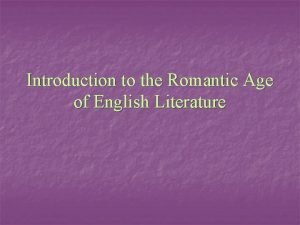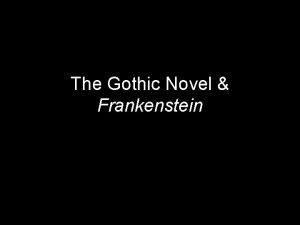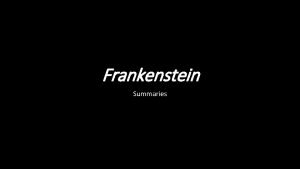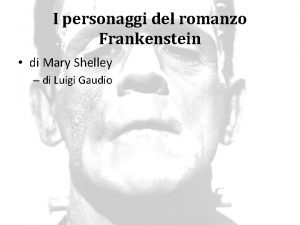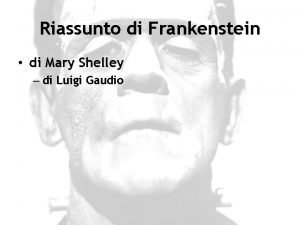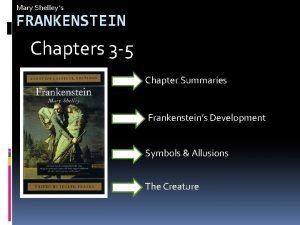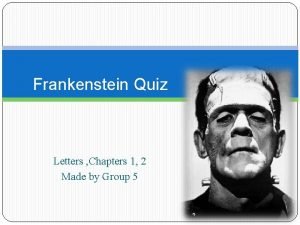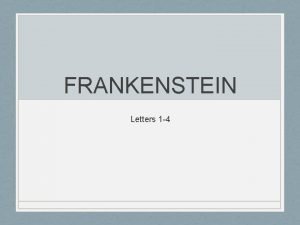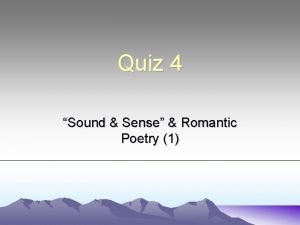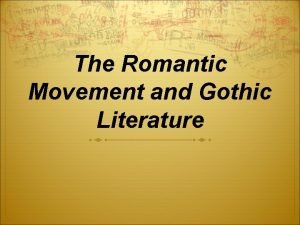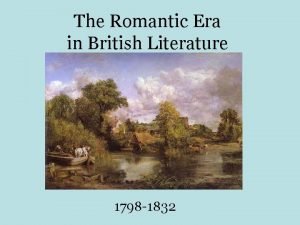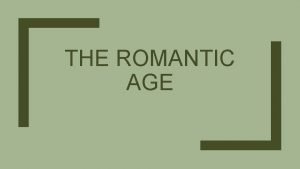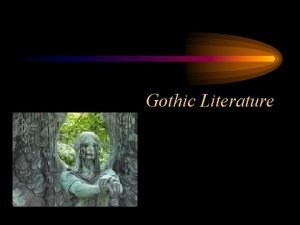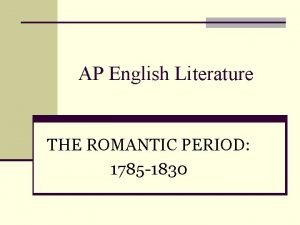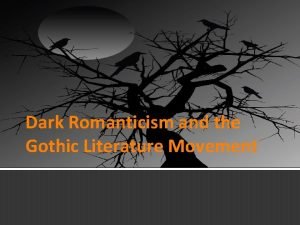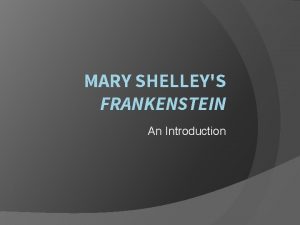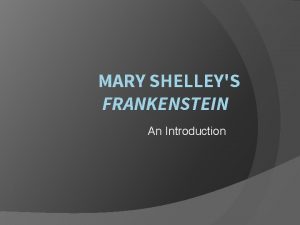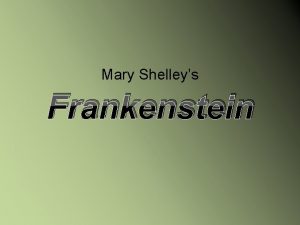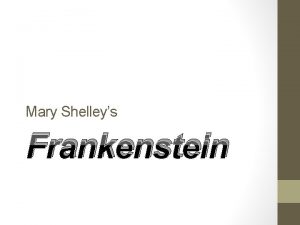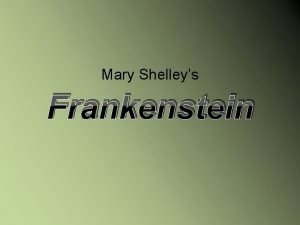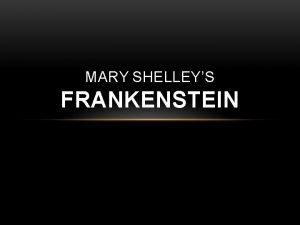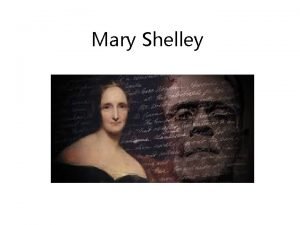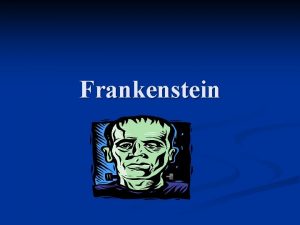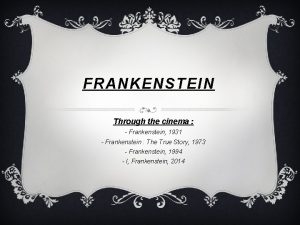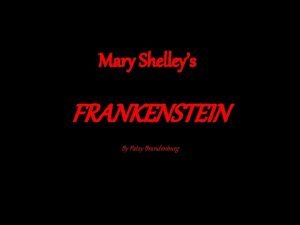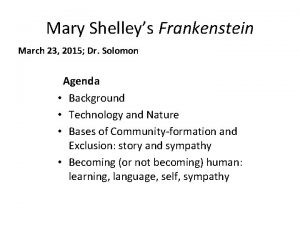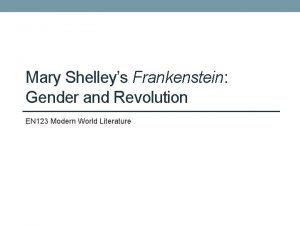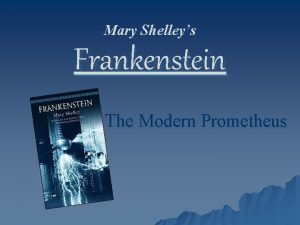Romantic Literature Introduction to Mary Shelleys Frankenstein QUIZ























- Slides: 23

Romantic Literature Introduction to Mary Shelley’s Frankenstein

QUIZ How romantic are you?

Question 1 I tend to make decisions based on… a. what my heart tells me. b. logic and reason.

Question 2 I often find myself daydreaming and using my imagination. a. True b. False

Question 3 When I need time to myself, I prefer to a. people watch, maybe at a coffee shop or other public place. b. go for a walk in the woods or find a place to sit outside.

Question 4 I would rather spend an afternoon a. teaching someone new information or skills. b. learning new information or skills.

Question 5 I would rather a. spend time doing my own thing b. spend time with a group.

Question 6 I feel more refreshed after an afternoon a. hanging out with friends b. hiking or spending time outside

Question 7 I believe that ___ is the most impressive. a. the wisdom of the past b. the progress of the future

Question 8 The answers to many of life’s problems can be found a. in nature. b. in friends and family. c. in television programs. d. in spirituality or my religion. e. in my own imagination. f. in the future of science and medicine.

Tally your answers! Question 1: A=3 B=1 Question 3: A=1 B=3 Question 2: A=2 B=1 Question 4: A=2 B=1

Question 5: A=2 B=1 Question 7: A=3 B=1 Question 6: A=1 B=2 Question 8: A, D, E = 3 B, C = 2 F=1

So, how romantic ARE you? 17 – 20 points Bring on Keats! Shelley! Byron! More Wordsworth, please! And can we study them outside, under the flowering trees? 12 – 16 points I wouldn’t mind reading some of the romantics, but I’d also be happy to hang out with friends afterwards. I need my social time. 8 – 11 points Can we just skip all this and stick to the facts?

Characteristics of Romanticism • Originated late 18 th century – Peak: 1800 -1850 – Frankenstein, 1818 • An artistic and literary movement. • Intuition over Intellect • Imagination • Emphasis on Nature • Individual, inner life

Romantic Art Identify the characteristics in the art….

Fishermen at Sea, by JMW Turner, 1794

Wanderer Above the Sea of Fog, by Caspar David Friedrich, 1818

Abbey in an Oak Forest, by Caspar David Friedrich, 1810

The Gothic • • • • • Setting in a castle An atmosphere of mystery and suspense Omens, visions Supernatural or otherwise inexplicable events High, overwrought emotion Women in distress Gloom and horror Footsteps approaching Lights in abandoned rooms Characters trapped in a room Ruins of buildings Thunder & lightening, rain Sights, moans, howls, screams Creaking doors and floors Gusts of wind blowing out lights Howling wolves/dogs Crazed laughter

Birth of Frankenstein • 1816 ghost storytelling contest. • Lord Byron, Mary, Percy (lover) • Inspired by a dream • Scientific experiments – Restoring life to dead – Drowning victims – 1800, James Blundell • Blood transfusions – 1790 s, Luigi Galvani • Electrostatic machine

Frame Narrative • A story within a story. – Sometimes within yet another story! • Often, different individual tells story of each frame. In Frankenstein… • Structure is symbolic • Thematic search in the story for something deep, dark, and secret at the heart of the narrative. • Like peeling off layers of an onion to get to the core • Represents psychoanalytic process • Uncovering the unconscious motives that are masked by a narrative told by the conscious mind. Frame Narratives in Frankenstein • Robert Walton sister, Margaret • Victor Walton – Monster Victor – Family Monster

Letters 1 -4 • Robert Walton (explorer) Margaret (sister) Letter 1 -trying to find North Pole -achieve something great Letters 2 -3 -lonely, lacks friends Letter 4 -spots sled guided by huge creature -spots another sled with starving man -takes man in and hears his story

Romantic Poetry • Read the following Wordsworth poems: – “Composed upon Westminster Bridge” (560) – “The World is Too Much with Us” (562) • Write a brief summary for each poem. • Create a double-entry journal with two entries (4 total) for each of the following: – 2 entries that show the tone of each poem – 2 entries that show elements of Romanticism • (one from the first poem and one from the second)
 Definition of romantic age
Definition of romantic age Romantic hero frankenstein
Romantic hero frankenstein Gothic novel frankenstein
Gothic novel frankenstein Romanticism
Romanticism Frankenstein symbols
Frankenstein symbols Mary shelley frankenstein biography
Mary shelley frankenstein biography Chapter 5 frankenstein summary
Chapter 5 frankenstein summary Frankenstein themes and symbols
Frankenstein themes and symbols Letter 1 summary frankenstein
Letter 1 summary frankenstein Narratore di frankenstein
Narratore di frankenstein Frankenstein riassunto per capitoli
Frankenstein riassunto per capitoli Chapter summaries of frankenstein
Chapter summaries of frankenstein Mary wollstonecraft mary a fiction
Mary wollstonecraft mary a fiction Frankenstein quizzes by chapter
Frankenstein quizzes by chapter What is robert walton's goal
What is robert walton's goal Romantic poetry quiz
Romantic poetry quiz The romantic period in american literature
The romantic period in american literature Romantic and gothic literature
Romantic and gothic literature Romantic period
Romantic period Augustan poetry vs romantic poetry
Augustan poetry vs romantic poetry Romanticism is
Romanticism is English romanticism characteristics
English romanticism characteristics Romanticism vs enlightenment
Romanticism vs enlightenment Dark romanticism vs romanticism
Dark romanticism vs romanticism
